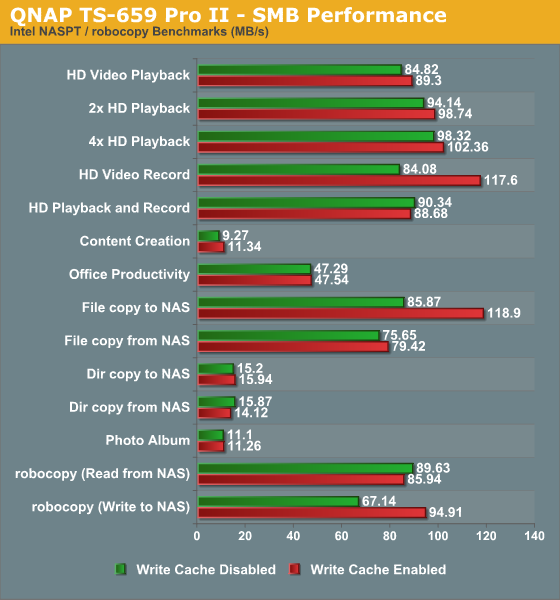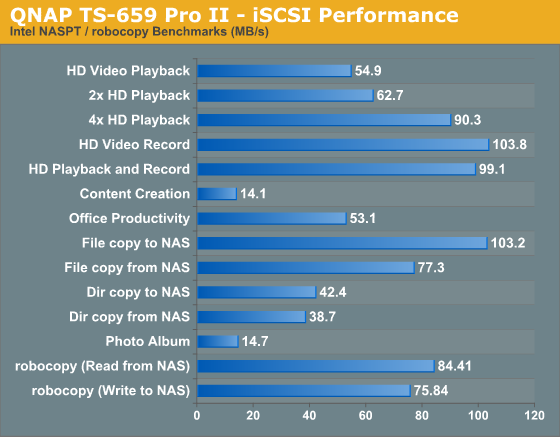QNAP TS-659 Pro II Review
by Ganesh T S on September 19, 2011 8:00 AM EST- Posted in
- IT Computing
- NAS
- QNAP
Samba shares can be set up easily by enabling the Microsoft Networking service. Under Access Rights Management, any of the folders in the NAS can be included in the 'Share Folders' section. Running the Intel NASPT benchmark and the robocopy tests gave us the following results:

Note that we have also run the benchmarks with the write cache enabled. This shows more than 35% improvement in the write intensive workloads, but the usual expected performance improvement is between 10 to 20% in general use. Unfortunately, it is recommended that the write cache be turned off for virtualized environments.
Moving on to iSCSI, it is again quite straightforward to enable the iSCSI service in the Disk Management's iSCSI subsection. The Target Management tab has a Quick Configuration Wizard to help create an iSCSI target and LUN.

In addition to the NASPT benchmarks for iSCSI, we also put the target through the HD Tune Pro benchmarks. The gallery below presents the various metrics of interest.
In order to test out NFS performance, we set up port trunking with 802.3ad for the ESA I340 in Ubuntu 11.04. rsync was used to replicate the robocopy command of transferring a 10.7 GB Blu-ray folder structure to the NAS and back from it.
| TS-659 Pro II NFS Performance in Ubuntu 11.04 | |
| Write to NAS | 67.83 MBps |
| Read from NAS | 61.30 MBps |
| . | |
















69 Comments
View All Comments
Death666Angel - Monday, September 19, 2011 - link
Hey! I just wanted to post a quick comment regarding this:"The redundancy helps in data recovery, in case of media failure of any other unforeseen circumstances."
Really, RAID only helps in case of a media failure. Most other "unforeseen circumstances" (which btw really aren't unforeseen...) cannot be helped by a RAID:
- unintentional deletion of a file
- virus
- power black out
- mainboard/PSU failure which fries the system
There are a lot of things that a RAID can do nothing about and need to be taken care of separately. I'm sure you know that, but the statement above made it sound differently. :-)
geniekid - Monday, September 19, 2011 - link
++Better to have data on two separate machines running no RAID than on one machine running RAID if data backup is your goal. RAID was designed primarily for enterprise use to minimize downtime when a drive fails - and even then, any serious business will have an offsite backup. In home use, the time-cost for replacing the hard drive on a non-RAIDed machine and then copying data from your backup machine is well worth the data safety you get from having that backup machine.
That said, external AND internal hard drives are both *relatively* cheap, so should be not-too-hard to get the benefits of both RAID and backup in home use :)
ganeshts - Monday, September 19, 2011 - link
I agree with your points :) But, the mainboard / PSU failure doesn't mean that data is lost. Please check out my LG N2A2 review, where I recovered data from a 'fried' system using UFS Explorer.I believe UFS Explorer can still be used here, but one needs to feed each disk into the rebuilding computer, make an image, and then recover after making UFS Explorer recognize all the images. I didn't check this out because I don't have a test system handy with ~6 TB worth of free space. Will try to redress in future :)
mino - Monday, September 26, 2011 - link
MoBo/PSU failure might easily take the disks with itself either by corrupting data or physicaly damaging them.Not to mention no way ofe getting them back withou getting identical mobo even if data was not touched AND hoping the new firmware will not zero them on sight ...
DeviousDog - Monday, September 19, 2011 - link
True!!! But data storage and backup are two different things. As the article states RAID helps with media falure.Just need to correct this
» unintentional deletion of a file - QNAP has a network recycle bin, so if you do delete a file it is not deleted. Only the soft link is deleted until you empty the recycle bin.
» virus - QNAP has an addon AntiVirus product, but then you should use Access Control Lists to protect data from virus and deletions.
» Power Black Out - Anyone that has a NAS, and does not have a UPS attached is a fool!!
» mainboard/PSU failure which fries the system - Use a UPS which has a clean line filter so the main board does not get a spike, even if it did fry the system. QNAP uses a software RAID so pull it out and put in another QNAP and re-apply the firmware and you are up and running again.
I agree though.. RAID is RAID it is not data protection (too a point) it is physical media protection for the RAID volume if a hard drive fails. That being said, there is nothing stopping you from making a 4 bay RAID 5 and then having a 1 or 2 bay RAID 0 on the same box for backup.
I have a TS-859 Pro + for personal use, I have a 5 Bay RAID 5 which is backed up onto the same QNAP which has 2 Bays holding 2 x 3TB drives in a RAID 0 for backup.
DeviousDog - Tuesday, September 20, 2011 - link
Oh.. forgot to also state, I then backup my box to another rsync server located at my brothers house through a VPN. Additionally I backup data to a cloud service for highly important stuff (photos), all of which the QNAP OS supports.Death666Angel - Tuesday, September 20, 2011 - link
All your points are very valid, as well. :DBut the article made it sound as though just having the redundancy is all you need. That was my main beef, as such a statement might lead the uninformed to set up a RAID array, put all their beloved old childhood photos and videos on it and then be surprise when there is a power outage which messes up all their data.
Yes, you can protect against black out, electrical spikes, viruses, unintentional deletion etc. But by other means than a RAID.
That was my point. Not that RAID is inherently dangerous. But that such a broadly worded statement is false and can lead uninformed people into dangerous situations. A brief 2 - 3 sentence paragraph about this stuff would suffice to enlighten most people to the problem, I think. :D
DeviousDog - Wednesday, September 21, 2011 - link
RAID is good (except RAID 0), the article does state it protects against media failure, meaning the physical disk. With the size of Hard Drives increasing any NAS in a RAID is a good choice, keep your data off your desktop or laptop, how many times have I seen people loose all the family photos due to a Drive Fault, this alone is a good reason to buy a NAS.However you shoud be Paranoid about your Data, back it up and store it out of your house. Its all good having a 6 Bay unit filled with 3TB drives, but then how do you back that data up... another NAS or rsync server.
You should always think that someone will break in and steal your NAS, or even fire or flood.
mino - Monday, September 26, 2011 - link
... in beef, as such a statement WILL lead the uninformed to...Fixed for ya!
CherryBOMB - Tuesday, September 20, 2011 - link
I have two QNAP;s as well 809's.photobucket.com/albums/xx165/goldcoin1/P9200347.jpg
for those who do not know the three latest firmwares have been 3.3 , 3.4 , and 3.5 In 3.4 they implemented RAID 10 capability.
Details of the firmware updates below.
3.3> http://www.qnap.com/fw_v3/
3.4> http://www.qnap.com/fw_v34/Default.aspx?lang=eng
3.5> http://www.qnap.com/fw_v35/features.asp
IMO QNAP is the way to go.